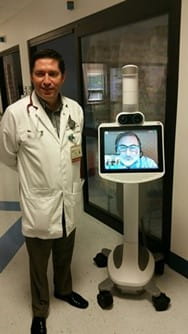Robot brings virtual visits from critical care specialists to the patient’s bedside.
 Tappahannock, Va. – Riverside Tappahannock Hospital is pleased to announce the addition of telemedicine services in its Intensive Care Unit. Through a partnership with Eagle Telemedicine, a company based out of Atlanta, Ga., hospitalists and staff at RTH now conduct rounds with the help of a robotic monitor that uses state of the art telecommunication and remote patient monitoring technology to connect with specialized physicians elsewhere.
Tappahannock, Va. – Riverside Tappahannock Hospital is pleased to announce the addition of telemedicine services in its Intensive Care Unit. Through a partnership with Eagle Telemedicine, a company based out of Atlanta, Ga., hospitalists and staff at RTH now conduct rounds with the help of a robotic monitor that uses state of the art telecommunication and remote patient monitoring technology to connect with specialized physicians elsewhere.
The system works similar to FaceTime with a large screen that displays a physician's face and allows that doctor to engage with the patient as well as the staff and hospitalists at RTH. The robot is wheeled into patient rooms, is equipped with a stethoscope and a high definition camera to aid in a detailed examination of the patient, including details such as pupil dilation.
“The ability to see a patient through a visual monitor allows for consultation and critical decision making to occur more rapidly,” says Judy Matthews, Nurse Executive at Riverside Tappahannock Hospital. “It helps us strengthen the quality, scope, and value of the critical care that we provide.”
Intensive care in a hospital is, as the name suggests, intense. Patients are in need of more extensive around-the-clock monitoring. For smaller hospitals, keeping ICUs staffed with specialists can be a challenge. Telemedicine offers a modern solution that extends resources, ensuring that all ICU patients have an additional layer of care. Hospitalists and ICU staff can consult in real time, at any time of day.
“Technology, when introduced the right way, can be so beneficial for patient care,” explains Dr. Jeffrey Sodowsky, a critical care intensivist who sees patients remotely at Riverside Tappahannock Hospital.
“A critical care intensivist and on site hospitalist conduct patient rounds twice daily with the telemedicine robot,” explains Dr. Alvaro Puig, a hospitalist at Riverside Tappahannock Hospital. “We are able to respond to patient needs in minutes and our ability to consult with a critical care specialist through telemedicine is sometimes even faster than if someone had to physically come from another part of the hospital.”
Telemedicine makes it possible to bring the expertise of a critical care physician to the patient’s bedside anywhere in the country. This level of care has been proven to improve patient outcomes. Hospitals across the country have reported decreased mortality and patients spending less time on ventilators when telemedicine is used in the ICU. In addition to being cost effective, telemedicine allows smaller and more rural hospitals to benefit from the same expertise that is available in larger urban settings. Sodowsky and his colleagues see patients, virtually, across the country.
“The team at Riverside Tappahannock Hospital is fantastic,” adds Sodowsky. “They are knowledgeable and focused on delivering excellent patient care.”
Sodowsky explains that even in his robotic form, he finds it easy to develop a rapport with hospital staff and patient family members. Often using humor to bring down the anxiety, he promotes the idea that robots are not weird and he’s a real person on the inside. And despite all the wonderful clinical advantages to the program, his favorite outcome is creating a personal connection with patient families.
“I had someone actually hug the robot,” Sodowsky says. “That’s one of the best outcomes I can report.”
